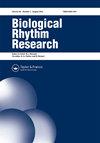黎明和黄昏合唱作为一个潜在的授时因子
IF 0.9
4区 生物学
Q3 BIOLOGY
引用次数: 1
摘要
千百年来,环境光暗循环提供了一个可靠的时间指标。它显示了光对每种动物的生理和行为的影响。此外,日出和日落(黎明和黄昏)通常是指当太阳的圆盘的上边缘在地平线上的一天的长度。有趣的是,在日出之前和日落之后有暮光(黎明和黄昏),在此期间有上层大气提供的自然光。有证据表明,过渡(黄昏)对于生物体昼夜节律同步(约=约;Dian =天)和circa =大约;年(年)节奏(季节性事件)。总的来说,我们认为光的所有特征都对动植物系统的行为和生理造成了重大变化。在这篇小型综述中,我们讨论了黎明和黄昏合唱的值得注意的方面,以及在白天和黑夜之间切换时观察到的行为变化。本文章由计算机程序翻译,如有差异,请以英文原文为准。
Dawn and dusk chorus as a potential zeitgeber
ABSTRACT Over millennia, environmental light-dark cycle provided a dependable indicator of time of day. It showed the effects of light on physiology and behaviour in every animal. Furthermore, sunrise and sunset (dawn and dusk) usually refer to the duration of day length when the upper edge of the sun’s disk is on the horizon. Interestingly, before the onset of sunrise and after sunset there is twilight (dawn and dusk), during which there is natural light provided by the upper atmosphere. Evidences suggested that transitions (twilight) are more essential to synchronize organisms circadian (circa = about; dian = day) and circannual (circa = about; annum = year) rhythms (seasonal events). Overall, we say that all the characteristics of light pose major changes in the behavior and physiology of animals and plant system. In this mini-review, we discuss the noteworthy aspects of dawn and dusk chorus and the behavioural changes observed during this switching between day and night times.
求助全文
通过发布文献求助,成功后即可免费获取论文全文。
去求助
来源期刊

Biological Rhythm Research
生物-生理学
CiteScore
3.00
自引率
9.10%
发文量
34
审稿时长
6-12 weeks
期刊介绍:
The principal aim of Biological Rhythm Research is to cover any aspect of research into the broad topic of biological rhythms. The area covered can range from studies at the genetic or molecular level to those of behavioural or clinical topics. It can also include ultradian, circadian, infradian or annual rhythms. In this way, the Editorial Board tries to stimulate interdisciplinary rhythm research. Such an aim reflects not only the similarity of the methods used in different fields of chronobiology, but also the fact that many influences that exert controlling or masking effects are common. Amongst the controlling factors, attention is paid to the effects of climate change on living organisms. So, papers dealing with biometeorological aspects can also be submitted.
The Journal publishes original scientific research papers, review papers, short notes on research in progress, book reviews and summaries of activities, symposia and congresses of national and international organizations dealing with rhythmic phenomena.
 求助内容:
求助内容: 应助结果提醒方式:
应助结果提醒方式:


